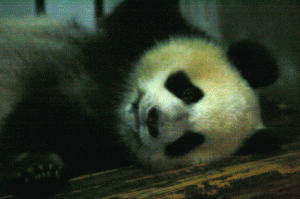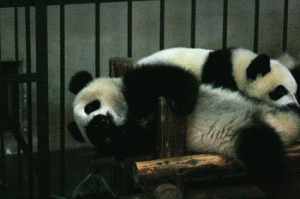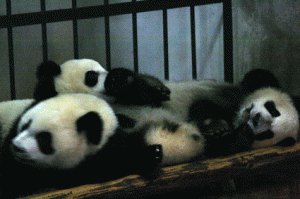Chinese languages reveals a lot about pandas. In Taiwan they refer to them as ‘cat bears’ – cuddly black-and-white animals, with Mickey Mouse ears and an endearing appetite for sitting around harmlessly chewing bamboo. Elsewhere in China, the emphasis switches and their name translates as ‘bear cats’. Wild. Untamed. Not fully understood.
In truth, they’re probably somewhere in the middle. But our understanding of panda behaviour is certainly improving, thanks in a large part to pioneering research currently being done in the Sichuan city of Chengdu, the so-called ‘panda capital of the world’.
To say that the city is proud of its connection with giant pandas is an understatement. I travelled there recently and saw images of pandas everywhere: they appear on the bonnets of the city’s taxis, on billboards, on all manner of souvenirs and even on cigarette packets.
Chengdu’s panda ambassadors
The Chengdu authorities have also recently appointed two ‘panda ambassadors’ – the Chinese actor Jackie Chan and British wildlife presenter Nigel Marven – to help raise awareness of the plight of this lovable yet threatened species, as well as the research being undertaken to try to preserve them. Chan adopted two pandas and donated £100,000 to research. Marven, meanwhile, has just finished filming a TV series about the pandas, which is due to be broadcast this autumn in the UK and then subsequently to a much wider audience worldwide.
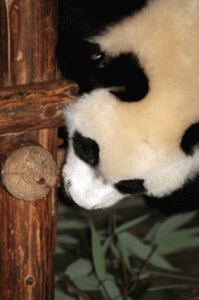
At the Chendgu Panda Base, however, you can see the real thing. Although the panda enclosures aren’t especially large and a heavy cloudburst on my arrival demonstrates just how the floods elsewhere in Sichuan have caused such devastation of late – it is nevertheless a real thrill to see them up close.
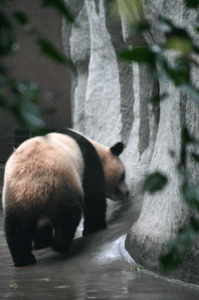 I’m saddened to see an adult pacing up and down restlessly, as pouring rain seeps into its fur, but am assured that they love the rain. And three one-year-old cubs inside the centre’s nursery building seem more than content, huddled up next to each other in a purposefully dimly-lit room. Wearing a mask and gown to avoid passing on any infection, I’m able to stand within just a few feet of them. They look like cuddly teddies, but one of the three opens its mouth to reveal a set of teeth that could easily shatter bone and I’m reminded of the giant panda’s wild side, even with ones so young. Soon it’s time to leave them be and I shuffle out of the room in my surgeon’s attire, smiling from an encounter I’ll never forget.
I’m saddened to see an adult pacing up and down restlessly, as pouring rain seeps into its fur, but am assured that they love the rain. And three one-year-old cubs inside the centre’s nursery building seem more than content, huddled up next to each other in a purposefully dimly-lit room. Wearing a mask and gown to avoid passing on any infection, I’m able to stand within just a few feet of them. They look like cuddly teddies, but one of the three opens its mouth to reveal a set of teeth that could easily shatter bone and I’m reminded of the giant panda’s wild side, even with ones so young. Soon it’s time to leave them be and I shuffle out of the room in my surgeon’s attire, smiling from an encounter I’ll never forget.
Pandas in the wild
An estimated 1800 giant pandas still live in their native habitat, the bamboo-covered mountains of Sichuan and neighbouring Shaanxi and Gansu provinces. A further 300 giant pandas are in zoos and preserves around the world, with just under a hundred here at the Chengdu Panda Base.
Several of these pandas were moved from the Wolong reserve to the north of Chengdu, after the UNESCO World Heritage site was severely damaged by a major earthquake that struck the region in 2008 – while more than 60 were relocated to the more spacious panda facility at Bifengxia, a few hours from Chengdu.
Although Wolong is still being rebuilt, George Schaller, who helped set up the centre has expressed his optimism about the future of pandas now that the study of pandas and captive breeding programmes is starting to generate results. Indeed, while I was in Chengdu a baby panda, named Jiao Qing, had just been born in the nursery at the panda base. It is hoped that if numbers can be secured in captivity then in time it may be possible to begin reintroducing some giant pandas into the wild – the key to their ultimate survival.
Eats shoots and leaves
For a long time it was thought that pandas simply wouldn’t mate in captivity but panda scientists now understand that they are intensely solitary animals in the wild and that the females are only on heat for a few days each year. For the rest of the year males and females cannot bear (excuse the pun) one another and will fight if put together. So staff at the centre now monitors the females closely so that they can place them with male pandas at the right time.
They are also pandering (again, sorry) to the animals needs in other ways – bringing them different types of bamboo and installing air conditioning in the breeding centre to help keep them cool.
“Pandas often give birth to twins”, Nigel Marven explains to me, “ and yet in the wild one would normally die.” The reason being that they are so small when they’re born, coupled with the fact that the mother cannot produce enough milk for two. But, he tells me, at the Chengdu centre they’re able to rotate the babies between mum’s milk and bottled milk. So now there is a good chance that both can survive in captivity – which again helps bolster those fragile panda numbers and hopes that one-day the giant panda might be removed from the endangered list.
“After making the series Panda Week I’m really optimistic about the future of giant pandas,” Marven adds.
Who knows, if the breeding and reintroduction to the wild scheme is successful then little Jiao Qing could be one of those released at some stage. I certainly hope so.


